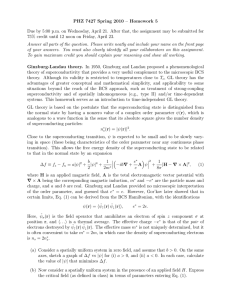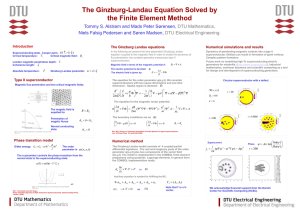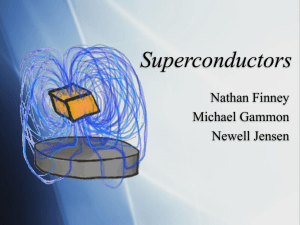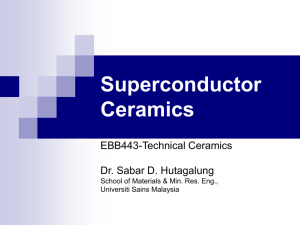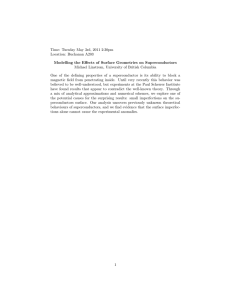superconductivity
advertisement
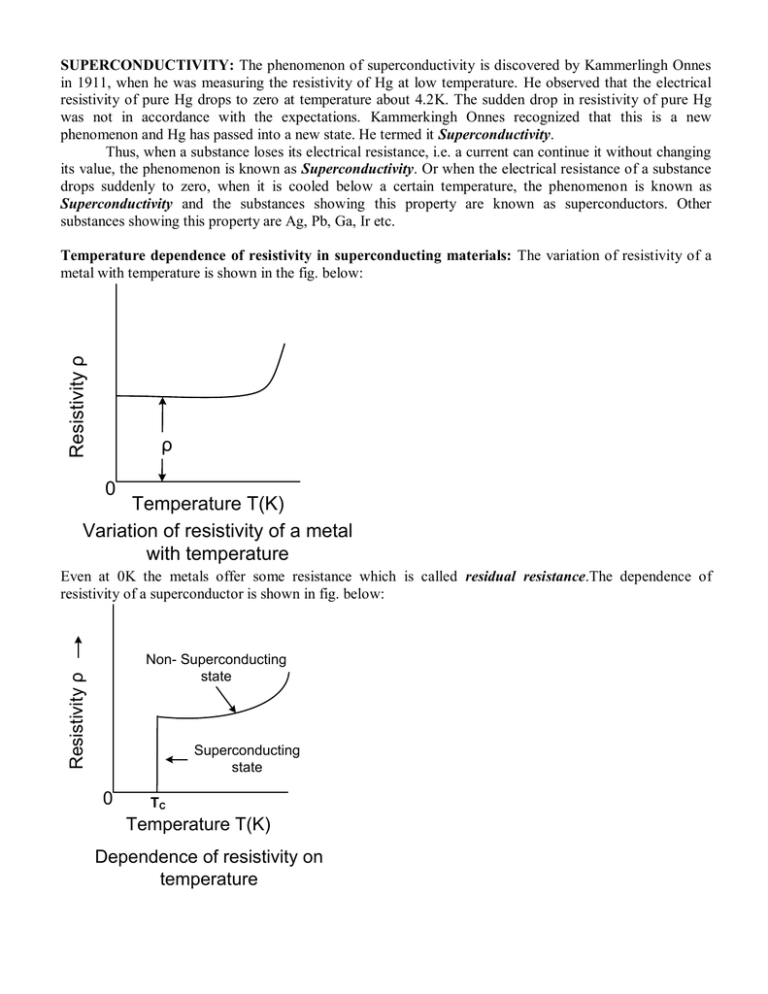
SUPERCONDUCTIVITY: The phenomenon of superconductivity is discovered by Kammerlingh Onnes in 1911, when he was measuring the resistivity of Hg at low temperature. He observed that the electrical resistivity of pure Hg drops to zero at temperature about 4.2K. The sudden drop in resistivity of pure Hg was not in accordance with the expectations. Kammerkingh Onnes recognized that this is a new phenomenon and Hg has passed into a new state. He termed it Superconductivity. Thus, when a substance loses its electrical resistance, i.e. a current can continue it without changing its value, the phenomenon is known as Superconductivity. Or when the electrical resistance of a substance drops suddenly to zero, when it is cooled below a certain temperature, the phenomenon is known as Superconductivity and the substances showing this property are known as superconductors. Other substances showing this property are Ag, Pb, Ga, Ir etc. Resistivity ρ Temperature dependence of resistivity in superconducting materials: The variation of resistivity of a metal with temperature is shown in the fig. below: ρ 0 Temperature T(K) Variation of resistivity of a metal with temperature Even at 0K the metals offer some resistance which is called residual resistance.The dependence of resistivity of a superconductor is shown in fig. below: Resistivity ρ Non- Superconducting state Superconducting state 0 TC Temperature T(K) Dependence of resistivity on temperature The superconductor in non superconducting state decreases with decrease in temperature as in case of normal metal. But at a particular temperature T c the resistivity abruptly drops to zero. T c is called as critical temperature. Temperature dependence of critical field: Kammerlingh onnes observed that superconductivity is destroyed if a sufficient strong magnetic field is applied and superconducting materials require a minimum magnetic field to regain the normal resistivity which is called critical magnetic field Hc. In other words the min value of magnetic field at which superconductor loses its superconductivity is called the critical magnetic field. The variation of critical magnetic field with temperature is shown in the fig. below: H C(0) HC1 NonSuperconductive HC HC2 (Normal state) Superconductive TC1 (Critical temperature) TC2 TC Temperature The curve is nearly parabolic and can be represented by the following T H T H 0 1 relation: C C 2 where, HC(T) is the max. critical field strength at temperature T, TC HC(0) is the max. critical field strength occurring at absolute zero and TC is the critical temperature. In general higher the value of TC higher the value of HC(0). Properties of Superconductors: Following are the few properties of superconducting materials: At room temperature, superconducting materials have greater resistivity than other elements. The transition temperature Tc is different for different isotopes of an element. It decreases with increasing atomic weight of the isotopes. The superconducting property of a superconducting material is not lost by adding impurities to it but the critical temperature is lowered. There is no change in the crystal structure as revealed by X-ray diffraction studies. This shows that superconductivity may be more concerned with the conduction electrons than the atom itself. The thermal expansion and elastic properties do not change in transition. All thermoelectric effects disappear in superconducting state. When a sufficient strong magnetic field is applied to superconductor below critical temperature its, superconducting property is destroyed. Meissner Effect: Meissner in 1933 observed that if a superconductor is cooled in a magnetic field, below critical temperature corresponding to that field, then the lines of induction are expelled from the material. This effect is called the Meissner effect. The expulsion of magnetic lines of force from a superconducting material when it is cooled below the transition temperature in a magnetic field is called Meissner effect. Following fig. shows a superconductor in normal state and the magnetic lines of forces pass through it. T>TC But when the specimen is cooled below its transition temperature as shown in the fig. the magnetic lines of force are expelled out of the specimen. Superconducting material Magnetic flux lines T<TC Important points: Meissner effect is reversible. When the temperature is increased below T C, the flux density suddenly penetrates through the specimen and the substance comes to its normal state. A superconductor is a perfect diamagnetic. The reason is that the magnetic induction B in a superconductor is zero. Therefore for superconductors, B 0 H M 0 or M H ………….. (1), where H = magnetic field intensity and M = intensity of magnetization. Since magnetic M H 1 , susceptibility χ is given by ………….. (2) , thus from (1) and (2) we get H H which is the max. value for the susceptibility of a diamagnetic material and thus a superconductor is a perfect diamagnet. B Maxwell’s equation is given by: E ………… (4). According to ohm’s law V IR and t IR JAR AR AR J E V d , E or E J where ………… (5) For finite J and d d d d B 0 or B = constant. Thus the condition of zero ρ, E should be zero. Thus from eq. (4), t resistivity predicts that magnetic flux should remain constant. This shows that the magnetic flux should not change when the specimen is cooled. This is in contradiction to Meissner effect. Therefore, the superconductors should be judged by both the conditions independently. So for a superconductor: o Has zero resistance below critical temperature. o Shows Meissner effect below critical temperature. The difference between a perfect conductor and a superconductor is that the former is only an ideal conductor while the later is simultaneously an ideal conductor and an ideal diamagnet. Type-I and Type-II superconductors: Based on magnetic behavoiur, the superconductors are classified into following two categories: 1. Type-I superconductors or soft superconductors 2. Type-II superconductors or hard superconductors Type-I superconductors: the dependence of magnetization of a superconductor of type-I as a function of external field H is shown in the fig. below: Magnetization Type-I superconductor Super conducting state Normal state External magnetic field It is obvious from the fig. that upto the critical field strength (H C), the magnetization of the superconductor grows in proportion to the external field. As soon as the applied field H exceeds H C, the magnetization abruptly drops to zero. So, type –I superconductor is one in which the transition from superconducting state to mirmal state in presence of magnetic field occurs sharply at the critical value H C. In presence of an external magnetic field H<HC, type-I superconductor in superconducting state is a perfect diamagnet. When H exceeds HC , the superconductor enters the normal state, i.e. it loses its diamagnetic property completely. In this state, the nagnetic flux penetrates throughout the superconductor. The critical field value HCfor type-I superconductor is found to be very low. Aluminum, lead and iridium are examples of type-I superconcductors. Type-II superconductors: the magnetization curve of type-II superconductor is shown in the fig. below: Type-II superconductor pe No ne flux tra tio n Magnetization B A Super conducting state H C1 Normal state Partial flux penetration C H C2 External magnetic field H The type-ii superconductor is characterized by two critical fields H C1and HC2. The curve describes the following features: 1. For the field strength below H C1, the superconductor expels the magnetic field from its body completely and behaves as a perfect diamagnet. HC1 is called lower critical field. The curve is represented by AB. 2. As the magnetic field increased from HC1, the magnetic field lines begin to penetrate thematerial. The penetration increases until HC2 is reached. HC2 is called the upper critical field. At HC2, yhr magnetization vanishes completely, i.e. the external field has completely penetrated into superconductor and destroyed the superconductivity. 3. In region from HC1 to HC, the specimen assumes a complicated mixed structure of normal and superconducting states. The superconductor is said to be in a mixed state which is commonly known as vortex state. In the region HC1 and HC2, the material is in a magnetically mixed state but electrically it is a superconductor. 4. After HC2, the material turns to normal state. So type-II superconductor is one which is characterized by two critical fields H C1and HC2, and transition to normal state takes place gradually as magnetic field is increased from H C1 to HC2.The most important advantages of type-II superconductor is the value of critical field HC2 which is many more times higher than the value of HC1 for type –I superconductor. So, the most important use of type-II superconductor is to build up a device which can work in high magnetic fields such as superconducting magnets. The examples of type-II superconductors are alloys like lead-indium alloy.
